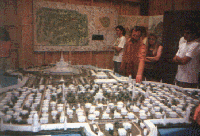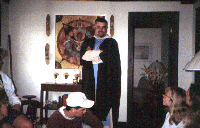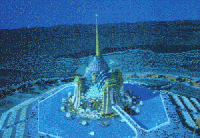City Of God Era at New Vrindavan
1988 - 1993
Within a year after his excommunication from ISKCON, Kirtanananda Swami
begins to reinvent New Vrindavan as an Interfaith City of God. His
vision included a walled city of potentially ten thousand
residents as well as the development of other Cities Of God
in various parts of the world. Architectural plans for a once South
Indian style temple begin to assume more gothic and Western
dimensions.
of potentially ten thousand
residents as well as the development of other Cities Of God
in various parts of the world. Architectural plans for a once South
Indian style temple begin to assume more gothic and Western
dimensions.
In the name of experimentation, Kirtanananda asked the devotees to
cooperate as he introduced Franciscan type robes, a pipe organ and
other Western instruments, silent meditation, and Krishna-ized Christian
hymns. The clean shaven look of Hare Krishna devotees was abandoned and
many men dawn beards. A statue of Christ was also placed next to the
statue of Srila Prabhupada in the temple. The organization was now known
as Interfaith League of Devotees. New Vrindavan started to organize
interfaith conferences.
was also placed next to the
statue of Srila Prabhupada in the temple. The organization was now known
as Interfaith League of Devotees. New Vrindavan started to organize
interfaith conferences.
Devotees of other traditions were invited to live in the community. Only
a few take up the invitation . And in the meantime many faithful
Hindu supporters became alienated by the changes, and some feel they have
been cheated since they have given large donations to construct an Indian
style temple.
. And in the meantime many faithful
Hindu supporters became alienated by the changes, and some feel they have
been cheated since they have given large donations to construct an Indian
style temple.
Soon, the whole interfaith concept started to encourage more changes to
the project. After a time the idea of a "city" was dropped. The plans
were modified to build an elaborate temple surrounded by a wall which
contained residential quarters . The name changed to the Cathedral of
Healing, and finally to Cathedral of the Holy Name.
. The name changed to the Cathedral of
Healing, and finally to Cathedral of the Holy Name.
Murti Swami, the chief architect at New Vrindavan for 10 years, departed
in the summer of 1993. During his stay he altered plans for Temple of
Understanding /Cathedral of the Holy Name 30 times.
Additional Images
1
2
3
4
5
6
7
8
9
10
11



